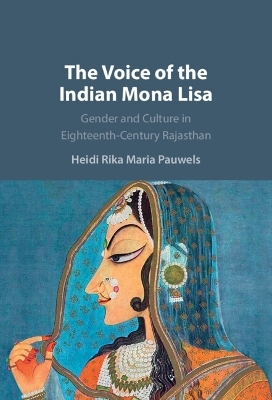
The Voice of the Indian Mona Lisa
Gender and Culture in Eighteenth-Century Rajasthan
Seiten
2023
Cambridge University Press (Verlag)
978-1-009-20165-0 (ISBN)
Cambridge University Press (Verlag)
978-1-009-20165-0 (ISBN)
Through literary and art-historical analysis, Pauwels brings to life the vibrant cultural production center of Kishangarh in the eighteenth century. Reconstructing how Banī-ṭhanī came to be acclaimed as 'India's Mona Lisa,' she conveys new insights in the history of Hindi literature, devotion, palace women, and social mobility of the enslaved.
The 'Indian Mona Lisa' is an eighteenth-century portrait of the goddess Radha from the Kishangarh school of Rajput Painting. It was purportedly modelled after a young enslaved woman and court-performer, Banī-ṭhanī, who became a concubine of the patron of the painting, crown-prince Savant Singh. Tracing her career, Heidi Pauwels recovers her role as a composer of devotional songs in multiple registers of Classical Hindi and shows how she was a conduit for trend-setting styles from Delhi, including the new vogue of Urdu. Through a combination of literary, historical, and art-historical analysis, she brings to life the vibrant cultural production center of Kishangarh in the eighteenth century by reconstructing how Banī-ṭhanī came to be acclaimed as the devotional poetess Rasikbihārī and as 'India's Mona Lisa'. This major new study conveys important new insights in the history of Hindi literature and devotion, the family, palace women and the social mobility of the enslaved.
The 'Indian Mona Lisa' is an eighteenth-century portrait of the goddess Radha from the Kishangarh school of Rajput Painting. It was purportedly modelled after a young enslaved woman and court-performer, Banī-ṭhanī, who became a concubine of the patron of the painting, crown-prince Savant Singh. Tracing her career, Heidi Pauwels recovers her role as a composer of devotional songs in multiple registers of Classical Hindi and shows how she was a conduit for trend-setting styles from Delhi, including the new vogue of Urdu. Through a combination of literary, historical, and art-historical analysis, she brings to life the vibrant cultural production center of Kishangarh in the eighteenth century by reconstructing how Banī-ṭhanī came to be acclaimed as the devotional poetess Rasikbihārī and as 'India's Mona Lisa'. This major new study conveys important new insights in the history of Hindi literature and devotion, the family, palace women and the social mobility of the enslaved.
Heidi Pauwels is Professor at the University of Washington, Seattle.
Introduction; 1. The making of the 'Indian Mona Lisa'; 2. The queen and the slave girl; 3. Becoming the prince's concubine; 4. Synergy of the literary couple; 5. Legacy: Self-fashioning and its limits; Conclusions.
| Erscheinungsdatum | 22.08.2023 |
|---|---|
| Zusatzinfo | Worked examples or Exercises |
| Verlagsort | Cambridge |
| Sprache | englisch |
| Gewicht | 592 g |
| Themenwelt | Kunst / Musik / Theater ► Kunstgeschichte / Kunststile |
| Geisteswissenschaften ► Geschichte ► Regional- / Ländergeschichte | |
| Geisteswissenschaften ► Religion / Theologie ► Hinduismus | |
| ISBN-10 | 1-009-20165-4 / 1009201654 |
| ISBN-13 | 978-1-009-20165-0 / 9781009201650 |
| Zustand | Neuware |
| Haben Sie eine Frage zum Produkt? |
Mehr entdecken
aus dem Bereich
aus dem Bereich
Erinnerungen
Buch | Softcover (2024)
Pantheon (Verlag)
CHF 22,40


